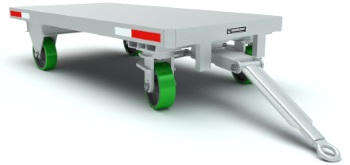Auto Steer Trailers
Capacity Range Up To 10,000 lbs.
 or
or
 Auto-Steer Trailer Showing Two Wheel Version
Auto-Steer Trailer Showing Two Wheel VersionOverview
When loads on trailers increase, the auto steer design is preferred for maximum stability. Since the wheels turn (on both two and four wheel steer models) and not entire axles, better lateral stability is provided during turns than a same-size fifth wheel steer trailer or four wheel steer. Utilizing frame design to lower the deck height contributes to this stability. Engineers understand that a lower center of gravity spread over a wider base is best for safety. Whether trailers will be part of trains or towed independently, auto steer is THE steering design of choice for load safety.
Quality Features
Keeping a train following the same path is critical in warehouses and distribution centers. Four wheel auto steer meets that requirement, while preserving maximum lateral stability. When a “dead end” aisle is part of the travel requirements, four wheel steer with a reversible tongue is a great option.
Steering linkage on four wheel steer trailers extends from the front and rear of the trailer, and can be vulnerable to lift trucks approaching from the side. For that reason, located on the sides between the front and rear wheels, each trailer is equipped with tie rod guards. Tie rods are precisely fit to keep the trailer towing properly, and may be easily damaged when forklifts attempt to raise a trailer with forks under the tie rod.
A major wear point on any towed trailer is the towing loop. Comprised of forged steel, Hamilton’s loops are built for handling the maximum towed load and are resistant to wear during years of use.
With a frame of 4” channel supporting a 7 ga. deck, these trailers define “robust”. Loading, unloading, and transit can introduce considerable impact load when handling five tons of material. Hamilton’s structure forms a base that is up to the task.
4” wide wheels with polyurethane tread provide the requisite load capacity along with a quiet ride and floor protection. Additionally, the tread is sufficiently “sticky” to keep trailering intact through turns.
Hamilton’s fabled MaxiDuty (MD) series caster assemblies support the wheels and also the center of the steering linkage. As an individual caster, the MD has a rated capacity of 23000#! This trailer essentially has a MD caster for each steering wheel. The adjustable tie rods permit finesse steering adjustments. Hamilton’s steering system is a strong point in the auto steer trailer line.
4-wheel steer vs. 2-wheel steer.
Trailers with 4-wheel steering provide the best tracking available, whether in auto steer or fifth wheel steering design. When all four wheels turn, the trailers in a train track in a nearly identical path through turns. While the trailers may cost a bit more, the gains in warehouse space through narrower aisles can be substantial. Additionally, longer trains may be towed through the warehouse if the steering is more accurate, vs. the two-wheel steering trailers.
The advantage of auto steer trailers, particularly in the 4-wheel steer design, is in their stability. Keeping the wheels “outboard” maintains stability during turns. The four wheel steer trailers with fifth wheel design surrender some lateral stability during turns as the footprint of the wheels narrows. Higher load centers of gravity or higher speeds during turns accentuate the problem. When load stability is vital, consider the 4-wheel auto steer design.
On-site visits available.
For pricing, submit Quote Request or call us: 1-888-699-7164.